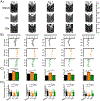Impact of Membrane Voltage on Formation and Stability of Human Renal Proximal Tubules in Vitro
- PMID: 35157435
- PMCID: PMC9906498
- DOI: 10.1021/acsbiomaterials.1c01163
Impact of Membrane Voltage on Formation and Stability of Human Renal Proximal Tubules in Vitro
Abstract
More than 15% of adults in the United States suffer from some form of chronic kidney disease (CKD). Current strategies for CKD consist of dialysis or kidney transplant, which, however, can take several years. In this light, tissue engineering and regenerative medicine approaches are the key to improving people's living conditions by advancing previous tissue engineering approaches and seeking new targets as intervention methods for kidney repair or replacement. The membrane voltage (Vm) dynamics of a cell have been associated with cell migration, cell cycle progression, differentiation, and pattern formation. Furthermore, bioelectrical stimuli have been used as a means in the treatment of diseases and wound healing. Here, we investigated the role of Vm as a novel target to guide and manipulate in vitro renal tissue models. Human-immortalized renal proximal tubule epithelial cells (RPTECs-TERT1) were cultured on Matrigel to support the formation of 3D proximal tubular-like structures with the incorporation of a voltage-sensitive dye indicator─bis-(1,3-dibutylbarbituric acid)timethine oxonol (DiBAC). The results demonstrated a correlation between the depolarization and the reorganization of human renal proximal tubule cells, indicating Vm as a candidate variable to control these events. Accordingly, Vm was pharmacologically manipulated using glibenclamide and pinacidil, KATP channel modulators, and proximal tubule formation and tubule stability over 21 days were assessed. Chronic manipulation of KATP channels induced changes in the tubular network topology without affecting lumen formation. Thus, a relationship was found between the preluminal tubulogenesis phase and KATP channels. This relationship may provide future options as a control point during kidney tissue development, treatment, and regeneration goals.
Keywords: kidney; membrane potential; proximal; tubulogenesis; voltage.
Conflict of interest statement
Competing interests
The authors declare no competing financial interest.
Figures



Similar articles
-
Developing a self-organized tubulogenesis model of human renal proximal tubular epithelial cells in vitro.J Biomed Mater Res A. 2020 Mar;108(3):795-804. doi: 10.1002/jbm.a.36858. Epub 2019 Dec 16. J Biomed Mater Res A. 2020. PMID: 31808276
-
Heparin-based hydrogels induce human renal tubulogenesis in vitro.Acta Biomater. 2017 Jul 15;57:59-69. doi: 10.1016/j.actbio.2017.05.035. Epub 2017 May 17. Acta Biomater. 2017. PMID: 28526628
-
Matrigel-Free Laminin-Entactin Matrix to Induce Human Renal Proximal Tubule Structure Formation In Vitro.ACS Biomater Sci Eng. 2020 Dec 14;6(12):6618-6625. doi: 10.1021/acsbiomaterials.0c01385. Epub 2020 Nov 16. ACS Biomater Sci Eng. 2020. PMID: 33320630
-
Maladaptive proximal tubule repair: cell cycle arrest.Nephron Clin Pract. 2014;127(1-4):61-4. doi: 10.1159/000363673. Epub 2014 Sep 24. Nephron Clin Pract. 2014. PMID: 25343823 Review.
-
Sugar or Fat? Renal Tubular Metabolism Reviewed in Health and Disease.Nutrients. 2021 May 9;13(5):1580. doi: 10.3390/nu13051580. Nutrients. 2021. PMID: 34065078 Free PMC article. Review.
Cited by
-
hTERT and SV40LgT Renal Cell Lines Adjust Their Transcriptional Responses After Copy Number Changes from the Parent Proximal Tubule Cells.Int J Mol Sci. 2025 Apr 11;26(8):3607. doi: 10.3390/ijms26083607. Int J Mol Sci. 2025. PMID: 40332109 Free PMC article.
References
-
- Levin M Bioelectric signaling: Reprogrammable circuits underlying embryogenesis, regeneration, and cancer. Cell. 2021. - PubMed
-
- Hille B Ion channels of excitable membranes. 3rd ed. Sunderland, Mass.: Sinauer; 2001. xviii, 814
Publication types
MeSH terms
Substances
Grants and funding
LinkOut - more resources
Full Text Sources
Medical
